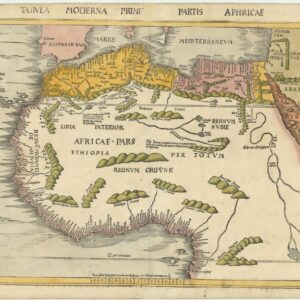Attractive 17th-century map of Egypt with ancient place names.
Aegyptus Antiqua Divisa in Nomos Authore P. Duval Abbevilliense Regis Christianissimi Geographo
Out of stock
Description
This is Pierre Duval’s presentation of the natural and cultural landscape of Ancient Egypt, published in Janssonius’ famed Atlas Major. It conveys a sense of this land of empires and kings from millennia prior, plotting and illustrating cities like Babylon, Memphis, and Nilopolis, rather than contemporary Arabic language centers like Cairo, Port Said, or Giza. The most easily recognizable city today is of course Alexandria, one of the premier cities of the ancient world. The pyramids are also shown.
The map is oriented to the west; the great deserts of Libya are located at top, the Mediterranean at right, the Red Sea and part of the Sinai Peninsula along the bottom, and Nubia to the left. The title cartouche states that the cartography is the work of Duval. The map has been dedicated to Doviat Sgr. de Montreuille, reflecting Duval’s royal connections to the French Court.
Cartographer(s):
Johannes Janssonius (1588 – 1664; born Jan Janszoon, also Jan Jansson) was a Dutch cartographer and publisher who lived and worked in Amsterdam in the 17th century. Janssonius was born in Arnhem, the son of Jan Janszoon the Elder, a publisher and bookseller. In 1612 he married Elisabeth de Hondt, the daughter of Jodocus Hondius. He produced his first maps in 1616 of France and Italy.
In the 1630s, Janssonius formed a partnership with his brother-in-law Henricus Hondius; they published atlases as Mercator/Hondius/Janssonius. Under the leadership of Janssonius, the Hondius Atlas was steadily enlarged. After Janssonius’s death, the publishing company was continued by his son-in-law, Johannes van Waesbergen. The London bookseller Moses Pitt attempted publication of the Atlas Major in English but ran out of resources after the fourth volume in 1683.
Pierre du ValPierre Du Val (1619–1683) was a prominent French geographer and mapmaker during the 17th century. Born in Abbeville, he was the son-in-law of the famous French cartographer Nicolas Sanson, often regarded as the founder of modern French cartography. Under Sanson’s tutelage, Du Val gained access to extensive geographical knowledge and advanced cartographic techniques, allowing him to develop his reputation in the field. His early work drew heavily from Sanson’s methods, but Du Val quickly distinguished himself through his meticulous attention to detail and the aesthetic quality of his maps.
Du Val became the official geographer to King Louis XIV in 1650, a prestigious role that placed him at the center of French mapmaking during an era of significant exploration and colonial expansion. He produced a wide array of maps, including regional maps of Europe, detailed globes, and thematic maps that covered subjects such as travel routes and fortifications. His works were celebrated for their accuracy and beauty, helping to elevate French cartography to international prominence. In addition to his maps, Du Val also published atlases and instructional materials, contributing to the education of future generations of geographers and explorers.
Condition Description
Minor smudges and remnants of hanging tape. Minor repairs. A fine, attractive image.
References
![[3-Sheet Biodiversity Map of Madagascar] Carte Internationale du Tapis Végétal et des Conditions Écologiques.](https://neatlinemaps.com/wp-content/uploads/2024/05/NL-01035-middle_thumbnail-300x300.jpg)


